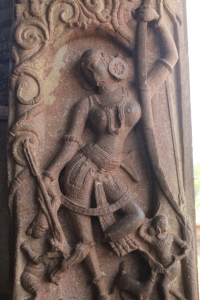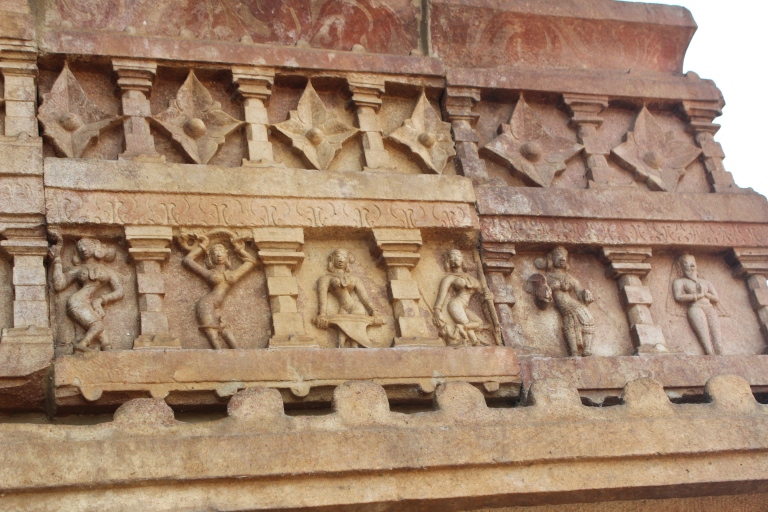When I decided to participate in the Go Heritage Run at Warangal, I found out about two particularly interesting temples – Ramappa & Ghanpur – that caught my attention. When I reached Warangal, I was told that these temples are both a couple of hours drive away from main Warangal town. After the Heritage run ended the next morning, I decided to head to these temples.
Ramappa is in a small town called Palampet around 70 kms from Warangal. The temple is a fine example of the pinnacle of Kakatiya Art.
It is also unique owing to the fact that it is probably the only temple, to not be named after the deity in the temple , but after the sculptor/architect Ramappa to whom the temple owes its beauty. As you pass the pathway leading to the temple dotted with trees , you are welcomed by an imposing structure. The first thing you will notice is the high, star-shaped plinth on which the temple is built. It is clear why the temple is known as the “brightest star in the galaxy of medieval temples in the Deccan”. The temple was constructed by the year 1213 during the reign of the Kakatiya ruler Ganapati Deva and took around 40 years to complete.
The temple is built entirely out of red sandstone giving the entire temple a beautiful pink hue.
As you walk around and inside the temple, you are struck by the intricacy and detailing of the exquisite sculptures and carvings. There is a running theme around the temple – of elephants engaged in war; if you look closely you will notice almost every elephant is unique.
Some of the carvings on the inner pillars are so intricate, you can easily pass a thread through them. The Kakatiyas were renowned for their miniature carvings.
There are three entrance porches around the temple around the garba gruha of the temple which have bracket figurines supporting the roof. These are in the form of two main running themes . One of these is a feature that I also noticed in some of the sculptures found in Khush Mahal complex in Warangal, which is basically a figure of a Vyaal (mythical creature), a man and an elephant.
The highlight of the temple is of course the 12 Mandakinis/Mohinis (set of 4 on each of the three side porches) who are depicted in strong poses of dance or war or daily life in black basalt stone. The striking feature of the figurines are, that they show women in positions of strength and power, which indicates the importance women were given during that era. We were told in our interpretation tour in the follow up to the run the previous day , that the lithe bodies depicted in the figurines were characteristic of the women in that era owing to the healthy diet they followed of jowar & pulses.
The most debated about one among these is a figurine who is said to wear high heels! Before I went to Warangal, I had got a whatsapp forward about this. But of course, these could easily be the khadau that are worn by Sadhus till this date.
The Nandi Mandapa opposite the Garba Gruha is worth a special mention. While the roof the mandapa seems to have collapsed, the main Nandi thankfully has remained intact. But there is something – a special power in the expression of the Nandi statue that looks like he is ready to attack as soon as his master, Lord Shiva commands!
Some say that some of these carvings on some of the pillars are those of erotic poses , but these are entirely open to interpretation ! 🙂
GHANPUR TEMPLE COMPLEX
My next stop was Ghanpur or Kottagallu as it is locally known, which is barely 30-40 mins from Ramappa. Even though I reached there in the peak afternoon, there was an overall eery feel to the place. But what’s more is the fact that it was in a nearly crumbling state . But, the more ancient and dilaipidated a temple is, the more mystery and intrigue it holds for me! 🙂
The scale and impact of the Muslim invasions on these ancient temples is very tangible here when you walk around the temple complex. The broken columns appear to be hanging precariously on a single point and walking around the temple makes you feel like the entire structure could come crashing around you.
It was very heartening to see a plaque stating that there is some restoration work in progress in the complex being undertaken by the Telangana government, although they clearly have a Herculean task at their hands.
It did help to overcome the slight trepidation I felt when I entered the place, seeing the old elderly priests inside the temple, so it was clearly a functional temple where the Linga is still being worshiped. In fact , there appeared to be a grand ceremony that happened recently .
I was pretty excited to see that the bracket figurines (Mandakinis) were also to be seen here at Ghanpur, but obviously lacking the lustre that they did at Ramappa.
There is a line of smaller shrines in a dilapidated state behind the main temple.

When you visit ancient temples, its not enough to restrict yourself to the main complex.

Take a walk around the complex and at every step, you will stumble upon a unique carving or sculpture! 🙂
































super like teja v very informative and it was a treat to watch these besides warangal photos r well take covering maximum details it was a feast to watch both temples
LikeLiked by 1 person
Thank you!
LikeLike
Very nice travelogue and photographs. Small submission that Ramappa Temple and the nearby irrigation tank were built by Recharla Rudra… not. Ganapati Deva
LikeLiked by 1 person
Thank you so much! Yes, I referred to the board at the entrance of the temple – stating that it was built by Recharla Rudra , who was a general under Ganapati Deva. Do correct me if I am wrong.
LikeLike
Recharla Rudra was the Commander in Chief of Kakateeya Ganapati Deva. The Temple building activitity of the Recharla Clan started prior to Kakateeyas and continued after the fall of the Kakateeyas as well for several centuries. Macharla in Palanadu prior to Kakateeyas,Pillala Marri (Near Suryapet, Nalgonda District), Rachakonda, Devarakonda, Devarakota ( Challapalli), Bobbili, Pithapuram, Jatprole, Venkatagiri, Mylavaram..
LikeLike
I think some of the black sculptures are made of basalt, the rest may be sandstone.
Ghaunpur temple is unusual in having separate parivara devata shrines. Like Kanchi and Ellora Kailasanatha temple, Vijayala Cholisvarm and Tirukkattalai in Pudukottai, TN
LikeLiked by 1 person
Thanks so much for your comments. Appreciate it! I had heard of the sand technology used , in some documentary i saw about Ramappa. I must have got it wrong. Updatedmy blog. Yes the black stone is basalt.
Can you explain what you mean by the parivara devata shrines in detail?
LikeLike